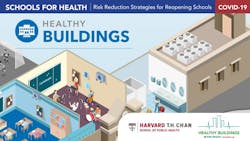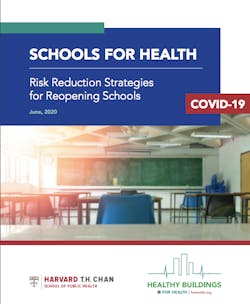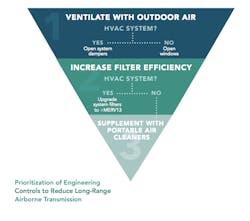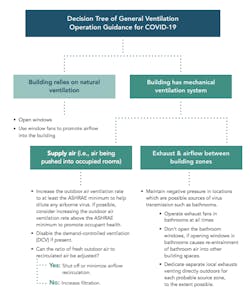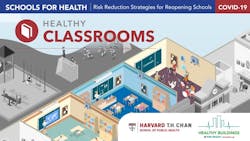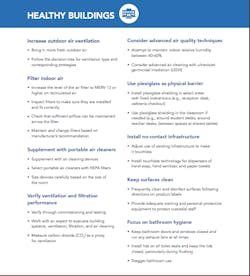Reopening Schools: Risk Reduction Strategies
The following excerpts are from a 60-page report released in June 2020 by the Harvard T.H. Chan School of Public Health. Entitled, "Risk Reduction Strategies for Reopening Schools," the document was written specifically to address public health concerns surrounding COVID-19, and to suggest how schools can safely mitigate risks ahead of the approaching start of the new term. Passages were chosen specifically for the HPAC Engineering audience. The full report can be downloaded here.
EXECUTIVE SUMMARY
Schools will eventually need to reopen.
Keeping schools closed comes with massive, long-term individual and societal costs. Many children cannot effectively learn, grow, engage, socialize, be active, eat healthy food, or get support until schools reopen. Parents and caregivers cannot go back to work until children go back to school. Knowing that schools will reopen at some point, we set out to answer this question: what strategies should schools consider to reduce risk of COVID-19 transmission? Note that a risk reduction strategy is different from a goal of achieving zero cases. There is no such thing as ‘zero risk’, in anything we do, and certainly not during a pandemic.
However, scientific evidence indicates that risks to students and staff can be kept low if schools adhere to strict control measures and dynamically respond to potential outbreaks. We recognize there are immense challenges. There is no perfect plan to reopen schools safely, only ‘less bad’ options. There is no ‘one size fits all’ strategy that works for every school. Schools have limited budgets and staff. Compliance will be imperfect. Learning will be different. There will be disruption. Schools may need to re-close unexpectedly depending on local conditions. No one knows with certainty what the fall will bring in terms of this pandemic.
Despite these challenges, the enormous individual and societal costs of keeping schools closed compels us, a team focused on Healthy Buildings and exposure and risk science, to present a range of control strategies that should be considered in discussions of school reopenings: Schools should adopt and adapt these recommendations to best fit their unique situation, depending on available personnel, resources, finances, school demographics, and building attributes.
HEALTHY BUILDINGS
Healthy building strategies that improve air quality and clean surfaces should be incorporated as part of a layered defense against COVID-19. For improving indoor air quality, we recommend prioritizing control strategies – ventilation, filtration, supplemental air cleaning – and verifying system performance regularly. For more detailed and technical guidance, we recommend reviewing the materials produced by the ASHRAE Epidemic Task Force. Schools should work with facilities managers and outside professionals to tailor these recommendations for their unique building systems.
INCREASE OUTDOOR AIR VENTILATION
- Bring in more fresh outdoor air;
- Follow the decision-tree for ventilation type and corresponding strategies.
SARS-CoV-2 present in the coughs, sneezes, and exhaled breath of an infectious person can be transported in the air to disperse throughout a room and can remain aloft for hours. This long-range airborne virus can infect even people who haven’t had close contact with the infectious person if they inhale a sufficient amount of virus. Bringing fresh outdoor air into a room can dilute and/or displace any present airborne virus, which thus reduces the probability that someone breathes enough infectious aerosol to become infected. As an ideal, holding class outdoors provides the freshest air and most effective dilution of any infectious airborne SARS-CoV-2.
As the next best solution, mechanical ventilation systems in buildings can forcibly bring outdoor air inside and then distribute that fresh air to different areas of the building. Some fraction of the indoor air is usually recirculated and mixed with the outdoor air coming in to save on cooling and heating energy costs. However, during a pandemic, when long-range airborne viral transmission can occur, air re-circulation can lead to a buildup of airborne viral particles indoors and also potentially spread the virus to other areas of the building.
Therefore, buildings should eliminate or minimize air re-circulation (thus maximizing fresh outdoor air) to the extent possible during this period. In addition, buildings should not shut off or reduce their mechanical ventilation during before-school or after-school hours when there still may be people in the building, including students, staff, and custodians during any student programs, cleaning times, teacher class preparation, sports (e.g., if students are returning to lockers), or other activities. Finally, mechanically ventilated schools should evaluate any potential contaminant source near the outdoor air intake duct. For example, the outdoor air inlet should not be located too close to the exhaust air outlet or contaminated indoor air that is exhausted out of the building could renter (refer to local building codes on minimum required distance, generally 10 feet).
Schools that do not have mechanical ventilation systems can increase the amount of natural ventilation via a) open windows, doors, or skylight, b) roof ventilators, c) stacks, and d) specially designed inlet or outlet openings. Opening windows can help bring in fresh outdoor air and dilute and exhaust contaminants in the indoor air. Natural ventilation through windows can be effective but is dependent on factors that drive pressure differentials between outdoors and indoors, like wind pressure and stack (or buoyancy) effects.
In some cases, it is not reasonable to bring in additional outdoor air. For example, on very hot summer days or very cold winter days it may not be impossible to maintain a comfortable temperature in the classroom if the windows are open. Mechanical ventilation systems, similarly, may need to recirculate more indoor air and bring in less fresh outdoor air when extremely hot or cold outdoor air cannot be sufficiently cooled or heated before it is blown into classrooms.
Other factors may also impact the ability to increase outdoor air ventilation, particularly for naturally ventilated buildings, including but not limited to, security concerns, high outdoor air pollution or pollen levels, or high outdoor noise levels. In these cases, the highest tolerable amount of outdoor air ventilation should still be used, even if students, teachers, and administrators have to adjust their clothing to be comfortable (e.g., wear a jacket indoors in the winter).
In cases where there cannot be adequate outdoor air ventilation, other strategies such as enhanced filtration and air cleaning can be used to reduce airborne SARS-CoV-2 concentrations.
FILTER INDOOR AIR
- Increase the level of the air filter to MERV 13 or higher on recirculated air;
- Inspect filters to make sure they are installed and fit correctly;
- Check that sufficient airflow can be maintained across the filter;
- Maintain and change filters based on manufacturer’s recommendation.
Filtration in school buildings can help mitigate long-range airborne viral transmission by removing SARS-CoV-2 from any air that is recirculated through the building. In buildings with mechanical ventilation systems, existing filters can be upgraded to filters with efficiency ratings of at least MERV 13 or the highest MERV rating the system can handle. MERV ratings, developed by ASHRAE, indicate the percentage of particles and the sizes of particles that filters can remove from air passing through them. Filters with higher MERV ratings remove higher percentages of particles and more effectively remove small particles than filters with lower MERV ratings. Filters with MERV ratings of 13 or higher are recommended for SARS-CoV-2 by ASHRAE. Filters need to be periodically replaced and inspected to make sure they are sealed and fitted properly, with no gaps or air bypass. In some cases, if the airflow distribution system is not designed to handle a higher MERV filter, air could leak around the filter edges, compromising any benefit that might have even been gained from a lower MERV filter.
SUPPLEMENT WITH PORTABLE AIR CLEANERS
- Supplement with air cleaning devices;
- Select portable air cleaners with HEPA filters;
- Size devices carefully based on the size of the room.
Portable air cleaners with high-efficiency particulate air (HEPA) filters may be useful to reduce exposures to airborne droplets and aerosols emitted from infectious individuals in buildings. Portable air cleaners are typically most effective in smaller spaces, and care must be taken when choosing a device to ensure it is the correct size for the room where it will be used. One metric to consider is the clean air delivery rate (CADR). The CADR reflects both the amount of air that a unit can process per unit time and the particle removal efficiency of the filter. A helpful rule of thumb is that for every 250 square feet of space, a CADR of about 100 cfm is desirable. CADR is not the only factor to consider. Portable air cleaners vary in their ability to circulate air in the room, so not all devices with the same CADR rating are equivalent. Devices that provide better mixing of the indoor air can capture particles from more of the room’s airspace and are therefore preferred.
Because potential viral sources could be in various locations within a room, it may be beneficial to have several units that meet the target CADR values rather than a single larger unit. In larger spaces, industrial-sized supplemental ventilation and filtration units are available and should be considered. Furthermore, room airflow patterns and the distribution of people in the room should be considered when deciding on air cleaner placement that maximizes source control and prevents airflow from crossing people. Since air cleaners should be operated while people are present, it may be important to compare different models to find one that does not generate disruptive noise.
VERIFY VENTILATION AND FILTRATION PERFORMANCE
- Verify through commissioning and testing;
- Work with an expert to evaluate building systems, ventilation, filtration, and air cleaning;
- Measure carbon dioxide (CO2 ) as a proxy for ventilation.
Mechanical heating, ventilation, and air conditioning (HVAC) systems in buildings tend to get out of tune. Within several years of construction, ventilation airflows may change from how they were designed. Schools can ensure that there is adequate ventilation and filtration through a process of commissioning and testing. Commissioning is the process of checking HVAC performance to ensure that systems are operating as designed. Commissioning and testing should be performed by trained individuals and should be performed throughout the school year.
In between commissioning events, there are several ways to test whether a classroom’s ventilation delivers sufficient outdoor air. In addition to working with trained experts, a school could quickly evaluate ventilation performance using carbon dioxide (CO2 ) as a proxy for ventilation using low-cost indoor air quality monitors. In an unoccupied classroom, background CO2 would be approximately equal to the concentration of CO2 in the atmosphere: 410 ppm. When students and teachers are present in a classroom, they exhale CO2 into classroom air at a relatively constant rate causing CO2 to rise above the background concentration. At some point, the concentration of CO2 reaches an equilibrium based on the amount generated indoors, and the amount diluted by ventilation. This is called ‘steady-state’ and can be used as a quick indicator of ventilation performance. If the measured CO2 concentrations while students are present are mostly below 1,000 ppm, then the outdoor air ventilation is likely reaching acceptable minimums. Lower CO2 concentrations while students are present mean there is acceptable outdoor air ventilation rates; higher CO2 concentrations suggest other strategies for increasing outdoor air ventilation are needed.
It is important to note that CO2 measurements are only useful when a full class of students is present; otherwise, ventilation will be overestimated. Also, while CO2 measurements are a good indicator of overall ventilation, they will not indicate whether other air cleaning interventions are effective. For example, if a classroom is operating portable air cleaners to remove the virus from air, viruses and other pollutants will be removed even if CO2 remains high because cleaners with HEPA filters are not designed to remove CO2 .
CONSIDER ADVANCED AIR QUALITY TECHNIQUES
- Attempt to maintain indoor relative humidity between 40-60%;
- Consider advanced air cleaning with ultraviolet germicidal irradiation (UGVI).
Additional air quality controls can be considered, including maintaining higher humidity and air cleaning with ultraviolet germicidal irradiation (UVGI). Because these controls require great care in implementation, they are listed in this separate section as advanced considerations. Schools that consider these approaches should consult with outside technical experts.
People’s physiological defenses against respiratory viral infection function best in mid-range humidity levels. Humidity also impacts environmental quality: dry environments are associated with higher incidence of some viral infections, such as influenza, but too much humidity can increase the presence of mites and lead to mold growth. While positive impacts of humidification on COVID-19 have not been determined, avoiding dry conditions in buildings is generally thought to be effective as a risk reduction strategy in buildings. ASHRAE suggests that maintaining relative humidity between 40% and 60% may help reduce COVID-19 infection rates.
For more information on indoor relative humidity and temperature combination set-points within this relative humidity range that are aimed at providing a healthy as well as a comfortable environment for occupants, for winter and summer operation, refer to the ASHRAE’s Pandemic Task Force’s reopening plan for schools and universities.
UVGI is an air cleaning technology that is sometimes used in buildings. UVGI uses low-wavelength ultraviolet light (UVC light) to destroy viruses. UVGI has been shown to be effective in disinfecting surfaces and air from bacteria and viruses such as influenza. In buildings, this technology is usually deployed as upper room UVGI to destroy airborne virus in the upper airspace of a room or as UVGI in supply air ducts to destroy airborne virus present in recirculated air. UVGI may be able to reduce exposures to airborne COVID-19.
- For more on UVC light, see HPAC Engineering's June 2020 cover story.
In order for UVGI to be effective, there must be sufficient contact time between the virus and the UV light; this often presents a challenge for installing an effective in-duct UVGI system. Similarly, upper room UVGI works best when the air in a room is well mixed so that airborne virus emitted by people in the lower portion of the room is lofted into the upper airspaces where it can be treated. Other potential issues with UVGI in schools include cost, maintenance, and potential health concerns of inadvertent UV exposures. In general, UVGI should be further discussed with an expert before consideration for use in a school.
##############
To access the full report, click here.
Thirteen authors contributed to this special report, led by Joseph G. Allen, Asst. Prof. of Exposure Assessment Science; Director, Healthy Buildings Program, Harvard T.H. Chan School of Public Health, [email protected].
